With Windows 8, Microsoft made changes to the boot experience. The simple text-based boot loader is now hidden by default and its place, there is a touch friendly graphical user interface with icons and text. Windows 10 has this as well. Although it is functionally richer, the UI is also very cumbersome to navigate and requires many OS components to be loaded before you see the GUI boot menu. In comparison, the classic boot loader in Windows 7 was extremely fast and gave you all the troubleshooting and startup related options on a single screen. For example, if you need to boot into the Safe Mode of Windows, you have to load this graphical boot UI first and then choose Safe mode. Today, we will see how to add the Safe mode option directly to the new boot loader on the screen where you get the OS choices.
Advertisеment
All we need to do is clone the current OS boot options and modify them to start the OS in Safe mode. This is very easy to do. We will use only the built-in bcdedit tool.
- Open an elevated command prompt.
- Type the following command:
bcdedit /copy {current} /d "Windows 10 Safe Mode"It will produce the following output:
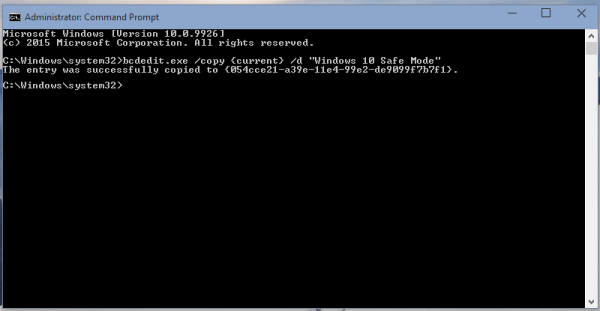
This command clones the current OS boot options to a new boot entry named "Windows 10 Safe Mode". - In the bcdedit output, note the {guid} value. Copy it and paste in the following command:
bcdedit /set {guid} safeboot minimal - If you want to add Safe Mode with networking support, copy the current OS boot options once again:
bcdedit /copy {current} /d "Windows 10 Safe Mode with Networking Support"It will also produce a new guid in the output.
Now modify it as follows, use your networking support guid instead of the {guid} part:bcdedit /set {guid} safeboot network - If you need to add the "Safe Mode (Command Prompt)" item, run the following commands:
- Make a new boot record again:bcdedit /copy {current} /d "Windows 10 Safe Mode (Command Prompt)"Note the {guid} value in the output.
- Modify it to run in Safe mode using the guid above:bcdedit /set {guid} safeboot minimal- Finally, make it use the command prompt instead of the Explorer shell:
bcdedit /set {guid} safebootalternateshell yes
Now reboot your PC and test the new options available in the boot menu: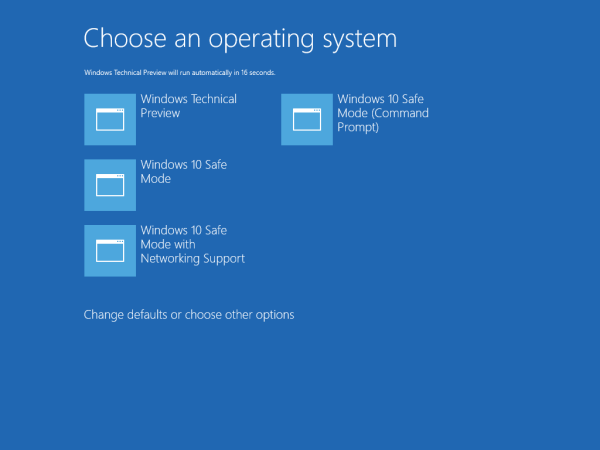
That's it.
Support us
Winaero greatly relies on your support. You can help the site keep bringing you interesting and useful content and software by using these options:
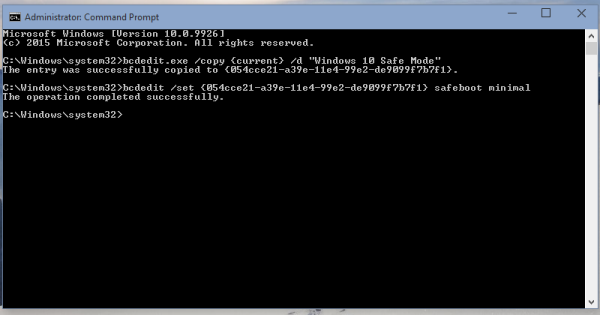
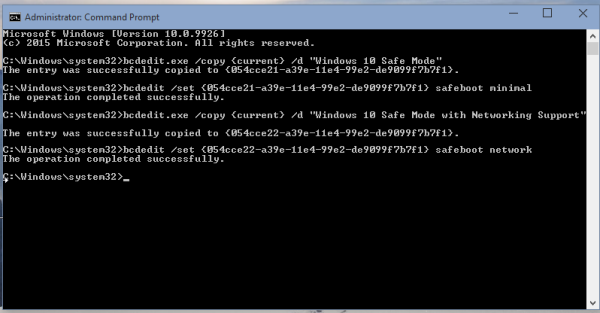
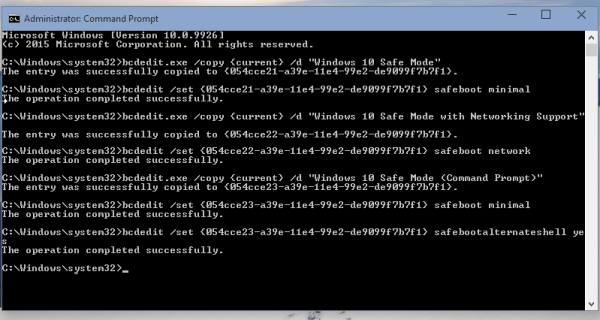

Excellent tip/guide! Quite useful again! Thanks Sergey! :)
You are welcome. Thank you for your kind words.
I will second that – great, detailed and useful post. Thanks, Sergey! :)
Excellent guide, as usual. Thanks, Sergey !
No problem on my machines where I have more than 1 OS installed but I plan to do this also on a friend’s computer, so :
1. Will the system show the options at boot even with 1 OS installed ?
2. If, for some reason, he wants to revert to the default bootloader, how do I proceed ?
Thanks for your advice ! :)
It will show anyway.
You will deal with the default bootloander in any case. All you need to do to “revert” these changes is the following command:
bcdedit /delete {GUID}Repeat the command above for all “safe mode” GUIDs you added.
If you forgot them, just run bcdedit without parameters, it will show all GUIDs.
Perfect !
Thank you very much. :)
You are welcome.
Hi, I did follow your guide but just one same GUI was generated through all steps. It’s that correct?
Then, any option guide me to same Windows normal (regular) start, not “safe mode” or “promt mode” in any case.
If I delete this (same for all options) GUI will have problems with Windows starter administrator option?
Thanks.
Every bcdedit /copy command should produce its own guid. I didn’t understand what you wrote about normal/regular start, and what you are going to delete. Can you explain me it?
Sergey,
I just reviewed my entries when I typed bcdedit and it looks like I got the same GUID every time as well. I did copy it all; if it would help you to review it, let me know and I would be happy to email it (the text file generated from the elevated prompt when I typed bcdedit, then copied it to notepad) to you. Again, thanks for your efforts. I haven’t rebooted to see if I get the options, but ask if having the same GUID will negatively affect the computer or cause problems. Please let me know.
Hi
Send me the output to my email . You can find it here:
https://winaero.com/blog/about-us/
I’m having the same problem; only one GUID with every command. The bootmanager shows all different options but it doesn’t matter what option I choose; Windows will start in normal mode
I’m having the same problem; only one GUID with every command. The bootmanager shows all different options but it doesn’t matter what option I choose; Windows will start in normal mode
EDIT: the mistake was caused by me! Now I have all boot options working and changed the commands in such a way that the boot options are in my own language (Dutch) now
You are absolutely awesome. Your instructions are incredibly detailed and everything works great. Information like this and the info about how to stop data collecting are invaluable and I for one vote for Sergey for President of the Internet! Thank you very much!
Cool article Serge. It would be nicer if you added same step by step way to undo each commands made, maybe on another article, i mean it’s always cool if one knows how to undo what was done as it is learning after all not just tinkering with our pc’s.
When I tried to undo them and entered bcdedit 5 columns came up, “Windows Boot Manager” on top followed by 4 “Windows Boot Loader”. All 5 columns have at least almost identical 2 guid-like values, on the right of the lines “default”, “resumeobject”, “displayorder”, “identifier”, “recoverysequence”, ect. Which of those values am I going to copy and paste to undo specific command we did above?
May you kindly field on this. Thanks.
Hi again sir, please help, I accidentally clicked and booted into safe mode with command prompt. the command prompt appeared once, i closed it but only a black screen appears, nothing else, i shut down my pc and powered it on again but same only black screen and my mouse pointer. How can I go back to rebooting in normal boot?
Merci Sergey
Does doing this allow you to skip Windows installing updates? Every time 8.1 tries to install them it hangs at 100%/30% and the only way to skip it is a system restore or refresh (Which means I have to reinstall Chrome) which takes forever. Getting to Safe Mode would be easy…except Windows decides it needs to install the updates first. It’s aggravating as hell.
On this site, there is a very nice solution. I tried it with success :
http://www.pcworld.com/article/2984712/windows/how-to-enter-windows-10s-safe-mode.html
You’ll get the same option screen you used to have in win 7 with all boot menu options.
You’ll need to make first a recovery drive usb key (everything will be deleted on this usb key!) to make the modification, to be done only once. Afterwards, to boot in safe mode, use the F8 key repeatedly, as you did in windows 7, during booting.
Really awesome. So Knowledgeable, so trustworthy, so well explained, so well written. So generous, too, to share all this capital of knowledge with everybody. I can only say that, if I get so much pleasure fumbling with computers (and I do!) it’s, in great measure, thanks to Sergey